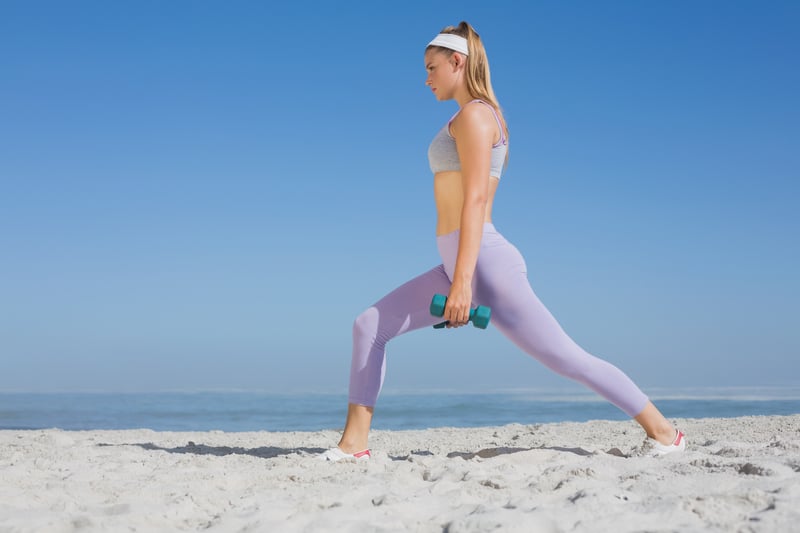Low-Impact Workouts with High-Impact Benefits

Can you still get fit with low-impact workouts? You bet! You don’t have to go through painful, tough-on-the-joints workouts just to get fit. But, don’t be fooled: low impact does not necessarily mean low intensity. Some low-impact workouts will have you begging for mercy, and you can get super fit without all the added stress on your body you’d get from high-impact activities.
What is Considered a Low-Impact Workout?
A low-impact workout is one that is relatively gentle on the joints of your body. It does not typically involve jumping or harsh starts and stops. A good rule of thumb is that one foot should be on the ground at all times during a low-impact workout. For example, you might think of standing and doing leg lifts, one at a time, versus bringing your knees to your chest repeatedly via jumping movements. Or, think about the impact that walking has on your body versus running. Yes, running may burn more calories (because you’re moving at a much faster pace), but you can still get to the same destination by walking. It will just be a slower, gentler pace that’s easier on the body.
Benefits of a Low-Impact Workout
How can you benefit from doing a low-impact workout? There are lots of ways:
1. There’s no barrier to getting started. No matter what your fitness level is, you can start with a low-impact workout.
2. You may be able to work around injuries and prevent future injuries. Because you can exercise without putting undue stress on joints, you may be able to do workouts you wouldn’t otherwise be in a position to perform. For example, if your knees are tender, jumping rope may be a bad idea but walking at an incline on the treadmill can get you the same results.
3. You still get all the benefits of high-impact exercise but without the downsides. Yes, it may take a bit longer to realize your results, but with consistency, they will come.
4. Because low-impact workouts are easy on the body, your recovery time from these workouts is also less. You can do a low-impact workout every day if you want to whereas with high-impact activities, your body will need and want some downtime to recover.
5. Low-impact exercise puts your body in the perfect position for fat burning. Instead of doing a high-impact workout that could put you into an anaerobic mode, low-impact moves keep you in the fat-burning zone for a longer period of time.
Top Low-Impact Workout Options
While low-impact workouts are certainly easier on your joints, that does not mean you get to take it easy. In fact, the exact opposite is true. These workouts are tough on fat and calorie consumption as well as your cardiovascular system, but they’re easy on the joints.
Weighted Walking Lunges
At first glance, this may not seem like an exercise that’s very tough. However, after a few reps, you will most likely feel differently. Begin by standing with a dumbbell or kettlebell in each hand, arms hanging straight down by your sides. (Start with light weight and work your way up.) Take a giant step forward with your right leg and bend at the knee as you lower the weights toward the ground. Push up through your right heel to propel yourself up and back to standing. Repeat the movement with your left leg. Continue for 20 steps before resting. Do three rounds.
Bike Sprints
If you ran sprints on a track, that could potentially wreak havoc on your joints. But, if you want all those benefits in the low-impact version, try interval training on a stationary bike. This amazing fat-burning technique is simple but far from easy. Start with a five-minute warmup, riding at a gentle pace. At the five-minute mark, pedal as fast as you can for a full 15 seconds, followed by 45 seconds of slower pedaling. Repeat the 15-/45-second sequence for 10 – 15 minutes and then finish off with a 5-minute cooldown. This might not sound like a tough workout, but it is guaranteed to kick your fat-burning into high gear.
Tabata Workouts
These fast-paced low-impact workouts are perfect for fat burning. The premise behind the Tabata workout is that you’ll burn maximal calories in a very short period of time using high-intensity interval training, but you won’t do any high-impact movements. How does it work? It’s a four-minute workout broken into 20- and 10-second intervals. You can use your own exercises, but here’s an example:
- 20 seconds of pushups
- 10 seconds of rest
- 20 seconds of kettlebell swings
- 10 seconds of rest
- 20 seconds of crunches
- 10 seconds of rest
- 20 seconds of body-weight squats
- 10 seconds of rest
You can repeat this sequence if you’re up for it or do it again, but switch up the exercises.
Circuit Training
This type of workout will help you strengthen your muscles and boost your cardiovascular fitness at the same time. Choose a weight circuit that will allow you to do one exercise for each body part. This can be done on machines, with free weights, or even your body weight. Perform each weight-training exercise for 15 repetitions and then do a minute of cardio in-between each exercise.
You can do step-ups onto a bench, body-weight squats, knees-to-chest movements, crunches, planks, or pushups as your in-between movement. Or, choose your own but keep moving for the 60 seconds between resistance training moves. Complete the entire strength-training exercise for each body part (chest, shoulders, triceps, biceps, legs, back, calves, abs) with 60 seconds of movement in-between each without stopping.
Rowing
If you’re bored with the treadmill, elliptical, and stair stepper or just want a change of pace, you may want to try your hand at the rowing machine. While it may appear to be a soothing exercise at first glance, it most assuredly is not. Rowing is a full-body, intense workout that will leave you breathless and burning fat like crazy. But the vast health benefits are worth the struggle. You’ll increase overall strength and cardiovascular fitness while clearing your head and shaking off the stressors of the day. If you want high-impact results from a great low-impact workout, this is a great way to build your power and endurance.
And don’t forget all the old standbys. If you want some simple low-impact training, you can always walk, bike, hike, or swim. Just be sure to increase the intensity (speed, elevation, duration) of your workouts to get high-impact benefits.




 7 Signs Your Body is Seriously Low on Collagen (not just wrinkles)
7 Signs Your Body is Seriously Low on Collagen (not just wrinkles) Health Expert: "Turmeric Doesn't Work (unless...)"
Health Expert: "Turmeric Doesn't Work (unless...)" 3 Warning Signs Your Probiotic Supplement is a Total Waste
3 Warning Signs Your Probiotic Supplement is a Total Waste

